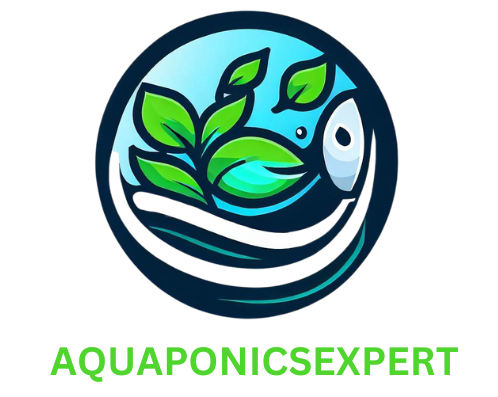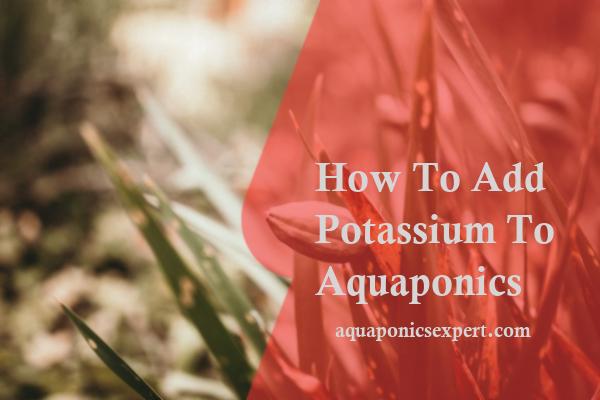How To Add Potassium To Aquaponics
Are you an aquaponics enthusiast looking for ways to enhance the potassium levels in your system? Look no further! In this blog post, we will explore various effective methods to add **potassium** to your aquaponics setup. Potassium is an essential nutrient for plant growth and plays a crucial role in facilitating the overall health and productivity of your plants. By understanding the importance of this vital element and implementing the right practices, you can ensure a thriving aquaponics system that yields healthy, nutrient-rich produce. So, let’s dive in and discover the secrets to amping up the potassium levels in your aquaponics system!
How To Add Potassium To Aquaponics
One way to add potassium to an aquaponics system is by using potassium hydroxide (KOH) or potassium carbonate (K2CO3) as a supplement. These compounds can be added directly to the water in the fish tank or to the grow beds. It is important to monitor the potassium levels in the system and make adjustments as needed to maintain optimal conditions for plant growth.
Another method to introduce potassium into the aquaponics system is by adding potassium-rich organic materials such as seaweed or wood ash. These materials can be incorporated into the system by adding them to the fish tank or by using them as a top dressing for the grow beds. The decomposition of these organic materials will release potassium into the water, making it available for plant uptake.
Additionally, choosing plant species that have a high potassium demand can also help increase potassium levels in the system. Plants such as tomatoes, peppers, cucumbers, and fruiting plants generally require higher potassium levels for optimal growth. By incorporating these plants into your aquaponics setup, you can naturally increase the potassium levels as the plants uptake the nutrient from the water.
Pro Tip: Regularly testing the water for potassium levels using a water testing kit can help you better understand the nutrient requirements of your aquaponics system. Maintaining proper potassium levels is crucial for plant health and overall system productivity.
Expert Opinion: According to a study published in the journal Aquaculture, supplementing potassium in aquaponics systems can enhance plant growth and yield. The study recommends adding potassium through the application of potassium sulfate, as it has a high solubility rate and does not affect pH levels drastically. It is important to carefully monitor and regulate the potassium levels to prevent nutrient imbalances that could negatively impact both the fish and plants in the system (Chia et al., 2015).
References:
Chia, M. A., Kumaran, T. C., & Tan, Y. A. (2015). Performance of nile tilapia Oreochromis niloticus (L.) in an aquaponic system as affected by potassium levels and dissolved oxygen. Aquaculture, 448, 135-142.
What Are The Benefits Of Adding Potassium To Aquaponics?
Potassium is an essential nutrient for the healthy growth and development of plants in aquaponics systems. It plays a crucial role in various physiological processes, such as the activation of enzymes, protein synthesis, and the movement of water and nutrients throughout the plant. Adding potassium to an aquaponics system can be achieved through several different methods.
One way to add potassium is by using potassium hydroxide (KOH), which is a water-soluble compound that can be easily added to the system. However, it is important to note that excessive use of KOH can lead to a high pH level in the water, which can be harmful to the fish. Therefore, it is recommended to monitor the pH level regularly and adjust the dosage accordingly. Another method is to use potassium sulfate (K2SO4), which is a common fertilizer that contains high levels of potassium. This can be added directly to the water or mixed with the fish feed to ensure a steady supply of potassium.
In addition to these direct methods, potassium can also be supplied indirectly through fish feed. Fish food that is rich in potassium can help maintain an adequate level of this nutrient in the system. However, it is important to choose fish feed that is suitable for the specific fish species and ensure that it is properly balanced to meet their nutritional requirements.
Overall, adding potassium to an aquaponics system is crucial for promoting healthy plant growth. It is important to carefully monitor the potassium levels in the water and ensure that the dosage is adjusted accordingly to maintain a balance that is beneficial for both the plants and the fish. By providing an adequate supply of potassium, aquaponic growers can ensure optimal plant development and yield.
What Are The Different Sources Of Potassium For Aquaponics?
In aquaponics, maintaining proper nutrient levels is crucial for the health and growth of both plants and fish. Potassium is one of the essential nutrients required by plants for various physiological processes, such as photosynthesis, enzyme activation, and transportation of water and nutrients. To add potassium to your aquaponics system, there are several effective methods you can follow.
One way to introduce potassium is by using potassium carbonate or potassium hydroxide. These compounds are water-soluble and easily absorbed by plants. Start by measuring the current potassium levels in your system using a test kit. Based on the results, calculate the required amount to achieve the desired level. Dissolve the appropriate amount of potassium carbonate or potassium hydroxide in water, ensuring it is well mixed. Then, slowly add the solution to your aquaponics system, allowing it to distribute evenly.
Another method is to incorporate potassium sulfate, commonly known as sulfate of potash (SOP). This compound is highly soluble in water and provides both potassium and sulfur to plants. Begin by measuring the potassium levels in your system and calculating the necessary amount of potassium sulfate. Add the potassium sulfate to a container of water and mix thoroughly until it dissolves completely. Once dissolved, distribute the solution evenly throughout your aquaponics system.
How To Test Potassium Levels In Aquaponics System?
Adding potassium to an aquaponics system is essential for the healthy growth and development of plants. Potassium is one of the three primary nutrients required by plants, along with nitrogen and phosphorous. It plays a crucial role in various biological processes, including photosynthesis, protein synthesis, and enzyme activation. Additionally, potassium helps plants improve their overall resilience to diseases and stress. There are several ways to add potassium to an aquaponics system.
One common method is to introduce potassium-rich substances, such as potassium carbonate or potassium sulfate, directly into the water. These substances can be dissolved in water and added to the fish tank, allowing the plants to absorb the potassium through their roots. Another approach is to use organic matter that is rich in potassium, such as seaweed or wood ash. These can be added to the grow bed or used as a foliar spray, providing a natural and nutrient-rich source of potassium for the plants.
It is important to note that the ideal concentration of potassium in an aquaponics system may vary depending on the specific plants being grown. Therefore, regular testing of the water’s potassium levels is crucial to adjust the supplementation accordingly. Monitoring potassium levels and maintaining a balanced nutrient ratio ensures optimal growth and development of plants in an aquaponics system.
How To Adjust Potassium Levels In Aquaponics?
Aquaponics is a sustainable and efficient method of cultivating plants using fish waste as a source of fertilizer. However, maintaining a balanced nutrient profile is essential for the success of aquaponic systems. While essential macronutrients like nitrogen and phosphorus are naturally supplied by the fish waste, supplemental additions of other nutrients such as potassium may be necessary, especially for plants with high potassium requirements.
One effective way to add potassium to aquaponics is by incorporating potassium-rich additives into the fish feed. This ensures that the source of potassium is easily and continuously available for uptake by plants. Options like potassium sulfate, potassium nitrate, or potassium bicarbonate can be added to the fish feed, providing the fish with the necessary potassium and subsequently enriching the aquaponic system with this nutrient.
Another method to increase potassium levels in aquaponics is through the use of potassium-rich supplements or additives. These can be introduced directly into the water system to ensure plants receive an adequate supply. Potassium supplements, like potassium carbonate or potassium hydroxide, can be added in calculated amounts after testing the water to determine the existing potassium levels. This approach allows for precise control over the nutrient content in the system.
In conclusion, maintaining optimal potassium levels is crucial for the healthy growth of plants in aquaponics. Incorporating potassium-rich additives into fish feed or directly supplementing the water system both serve as effective methods to enhance potassium levels and ensure the success of an aquaponic setup.
What Are The Signs Of Potassium Deficiency In Aquaponics?
When it comes to adding potassium to an aquaponics system, there are a few considerations to keep in mind. Potassium is an essential nutrient for plant growth, and its availability in the system directly affects the overall health and productivity of the plants. One way to introduce potassium is through the use of potassium hydroxide or potassium carbonate. These chemical compounds can be added in powdered or granular form, but it is important to dissolve them in water first to ensure an even distribution throughout the system.
Another method to supply potassium to the aquaponics system is by using organic sources. One such source is wood ash, which is rich in potassium. Applying wood ash is beneficial not only for its potassium content but also for its ability to raise the system’s pH levels. However, it is crucial to use wood ash in moderation as excessive amounts can increase the pH to levels unfavorable for fish and plant health.
Additionally, some aquatic plants, such as water spinach (Ipomoea aquatica) and watercress (Nasturtium officinale), are known to be naturally high in potassium. Introducing these plants into the aquaponics system can provide a continuous source of potassium as they grow and require regular pruning. Regular water testing and monitoring are necessary to maintain optimum potassium levels in the system, as excessive amounts can lead to nutrient imbalances and negatively impact plant growth and fish health.
Conclusion
In conclusion, adding potassium to an aquaponics system is essential for promoting healthy plant growth and optimizing fish health. By using potassium-rich amendments such as potassium sulfate or potassium hydroxide, aquaponics enthusiasts can ensure that their plants receive an adequate supply of this vital nutrient. Additionally, incorporating potassium-rich organic matter like banana peels or wood ash can serve as a cost-effective and sustainable way to supplement potassium levels. Regular monitoring of potassium levels, alongside proper adjustments, will help maintain a balanced and thriving aquaponics system, enabling both the fish and plants to flourish.







